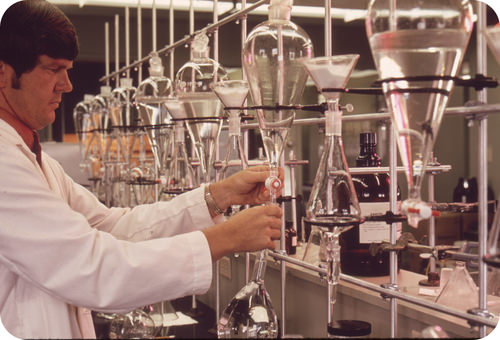1.5 理论化学和应用化学
章节大纲
-
How does research enable us to understand chemistry?
::研究如何让我们了解化学?How did chemistry develop? What is happening in the field of chemistry today? What can I do with a chemistry degree? All of these are good questions and they should be asked by students interested in chemistry. in chemistry (or any other field, for that matter) is interesting and challenging. But there are different directions a person can take as they explore research opportunities.
::化学如何发展?今天化学领域发生什么了?我可以用化学学位做什么?所有这些问题都是很好的问题,应该由对化学感兴趣的学生来问。化学(或其他任何领域,例如化学领域)是有趣而富有挑战性的。 但是,人们在探索研究机会时可以采取不同的方向。Pure and Applied Research
::纯研究和应用研究The study of modern chemistry can be split into two types of research: pure and applied. Chemists who study pure chemistry do research primarily to advance mankind's understanding of chemistry. Pure chemistry is concerned with a greater understanding of the theories behind how matter is changing in . Pure chemists tend to be less concerned with direct applications of the research that they are doing. That is not to say that pure chemistry can never lead to a real-world application but, rather, that a potential application is not the primary motivation for doing the research in the first place. Applied chemistry is chemistry that is directed toward a specific practical goal or application. The video below further describes applied research.
::现代化学研究可以分为两类研究:纯化学和应用研究。研究纯化学的化学家们所做的研究主要是为了提高人类对化学的认识。纯化学关心的是更深入地了解物质变化背后的理论。纯化学家们往往不太关心他们所从事的研究的直接应用。这并不是说纯化学永远不能导致现实世界的应用,而是说潜在应用不是首先进行研究的主要动机。应用化学是针对特定实际目标或应用的化学。下面的录像进一步描述了应用研究。Pure Research Examples
::纯粹研究实例The early contains many examples of pure research. The ancient Greek philosophers debated the composition of matter (earth? air? fire? water? all of the above?). They weren’t going to do anything with their knowledge – they just wanted to know. Studies on the (especially after Mendeleev’s periodic table was published) were primarily “pure” research types of experiments. Does this element exist? What are its properties? The scientists did not have any practical application in mind, but were curious about the world around them. Below are some examples of questions where pure research would be used:
::早期有许多纯研究的例子。古希腊哲学家争论物质的组成(地球? 空气? 火? 水? ? 以上所有这一切? ) 。他们不会用他们的知识做任何事情 — — 他们只是想知道而已。 有关研究(特别是在门捷列夫定期表发表之后 ) 主要是“纯”研究类型的实验。 这个元素存在吗? 它的属性是什么?科学家们没有想到任何实际应用,但对周围的世界很好奇。 下面是使用纯研究的一些问题的例子:-
How was the universe formed?
::宇宙是如何形成的? -
Is there life on
Mars
?
::火星上有生命吗? -
What are
, neutrons, and electrons composed of?
::什么是,中子,电子是由什么构成的? -
What are the properties of boron?
::波伦的特性是什么?
Applied Research Examples
::应用研究实例There is a great deal of “applied” research taking place today. In general, no new science principles are discovered, but existing knowledge is used to develop a new product. Research on laundry detergents will probably not give us any new concepts about soap, but will help us develop materials that get our clothes cleaner, use less water, and create lower amounts of pollution. Petroleum companies use applied research to find better ways to power vehicles, better lubricants to cut down on engine wear, and better ways to lower air pollution. These companies will use information that is readily available to come up with new products.
::当今正在发生大量“应用”研究。 总的来说,没有发现新的科学原则,但现有知识被用于开发新产品。 洗衣洗涤剂研究可能不会给我们带来任何关于肥皂的新概念,但会帮助我们开发材料,使我们的衣服更清洁,用水更少,污染程度较低。 石油公司利用应用研究寻找更好的汽车动力、更好的润滑油来削减引擎磨损,以及更好的减少空气污染的方法。 这些公司将使用现成的信息来开发新产品。U.S. Air Force Technical Sergeant Shanice Spearman at Aerospace Fuels Laboratory NCO prepares fuel samples for flashpoint testing. "In-Between” Examples
::“在-在-在”实例The line between pure chemistry and applied chemistry is not always distinct. What may start out as simply asking a question may result in some very useful information. If scientists are studying the biochemistry of a microorganism that causes a disease, they may soon find information that would suggest a way to make a chemical that would inactivate the microorganism. The could be used to learn more about the biochemistry, but could also be used to cure the disease.
::纯化学与应用化学之间的界线并不总是不同。 一开始只是问一个问题,可能带来一些非常有用的信息。 如果科学家们正在研究造成疾病的微生物的生物化学,他们可能很快会找到信息来说明如何制造一种能使微生物不活跃的化学。 这些信息可以用来更多地了解生物化学,也可以用来治愈这一疾病。Hemoglobin is a in red blood cells that transports oxygen in the bloodstream. Scientists studied hemoglobin simply to learn how it worked. Out of this research came an understanding of how the protein changes shape when oxygen attaches to it. This information was then applied to help patients with sickle cell anemia, a disorder caused by an abnormal hemoglobin structure that makes hemoglobin molecules clump up when oxygen leaves the protein. Basic knowledge of protein structure led to an improved understanding of a wide-spread disease and opened the door for development of treatments.
::血红蛋白是一种在血液中输送氧气的红细胞中的血红蛋白。科学家们研究血红蛋白只是为了了解血红蛋白是如何起作用的。从这项研究中,人们了解到了蛋白质如何随着氧气的附着而变化。然后,这一信息被用于帮助镰状细胞贫血病人,这种贫血症是由异常的血红蛋白结构引起的,它使血红蛋白分子在氧离开蛋白时聚集在一起。关于蛋白质结构的基本知识导致人们更好地了解一种广泛传播的疾病,并为治疗的发展打开了大门。Summary
::摘要-
Pure research focuses on understanding basic properties and processes.
::纯粹研究的重点是了解基本特性和过程。 -
Applied research focuses on the use of information to create useful materials.
::应用研究的重点是利用信息编制有用的材料。 -
Sometimes there is no clear line between pure and applied research.
::有时,纯研究和应用研究之间没有明确的界限。
Review
::回顾-
What is pure research?
::什么是纯粹的研究? -
What is applied research?
::什么是应用研究? -
Give one example of pure research.
::举一个纯粹研究的例子。 -
Give one example of applied research.
::举一个应用研究的例子。 -
Is it always easy to classify research as pure or applied? Explain your answer.
::将研究归为纯研究或应用研究总是很容易吗?
-
How was the universe formed?

